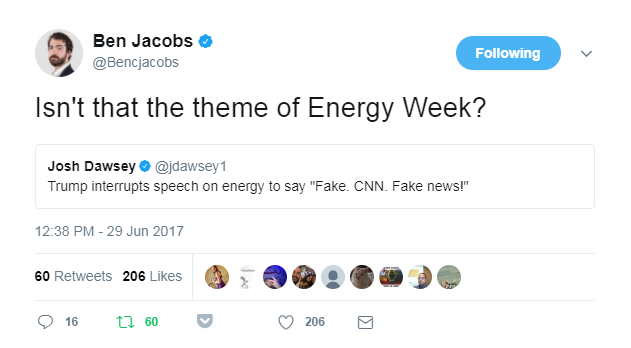You’ll have to forgive anyone but the closest observers of the energy and environmental worlds if they didn’t realize this was Donald Trump’s self-proclaimed “energy week.” Alas, the and its fossil fuel allies. Blink and you might have missed it. Trump’s handful of tweets and a brief, bare-bones speech betraying his shallow understanding of energy policy were clearly overshadowed by his attacks on the media and—in the energy world—easily countered by the news of more growth in the clean energy economy and an increased transition away from fossil fuels.
Let’s check in on Twitter to see how Trump’s crystal clear focus on energy was received:
2) https://twitter.com/kylegriffin1/status/880773949709221888
3) https://twitter.com/MaraLiasson/status/879325160490360832
4) https://twitter.com/jonathanvswan/status/879841493632110597
5) https://twitter.com/MattNegrin/status/880832696590708741
Meanwhile, in the real world, stories have been rolling in from across the country about the transition from coal to clean energy.
In the West, Pacificorp is moving forward with a 20-year plan that reduces its use of coal-fired power while expanding investments in wind energy. The utility, which serves six western states, has proposed spending $3.5 billion on a plan to add 1,100 megawatts of new wind energy—mostly in Wyoming—as well as a new transmission line. Local outlet, KUOW, has the best headline we've seen, "PacifiCorp Looks To Expand Wind Energy As Coal Plants Retire."
Pacificorp wasn't the only wind proponent to push back against Trump recently. During a recent speech in Iowa, Trump made disparaging comments about wind power, which ironically powers more than a third of the Hawkeye state and employs 8,000 Iowans. His comments created an immediate backlash from the state's wind industry, Senator Chuck Grassley (R-IA), and the American Wind Energy Association's president, Tom Kiernan.
It isn't just Iowa and Pacificorp that have ignored Trump's call for more fossil fuels, either. Recent news coverage shows that big, multinational companies are the biggest drivers of clean energy development. Last year, for example, nearly 40 percent of U.S. wind contracts were signed by corporate power users, along with university and military customers. That's up from just 5 percent in 2013. These users also accounted for an unprecedented 10 percent of the market for large-scale solar projects in 2016. Research shows that this trend is set to continue.
In the meantime, clean energy deals and coal plants retirements (and curtailments) have continued unabated since the beginning of the month. For example, Sibley coal power plant in Missouri announced its closure by 2018, Minnesota's second major solar project began its operations, and mayors across the country continued to join the #WeAreStillIn movement at the annual United States Conference of Mayors.
Not to mention, as the Washington Post notes:
https://twitter.com/washingtonpost/status/880422246925430784
